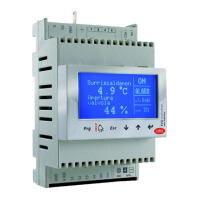37
ENG
“EVD evolution” +030222041 - rel. 1.0 - 01.06.2008
ALARMS9.
Alarms9.1
There are two types of alarms:
system: valve motor, EEPROM, sensor and communication;•
control: low superheat, LOP, MOP, high condensing temperature, low •
suction temperature.
The activation of the alarms depends on the setting of the threshold and
activation delay parameters. Setting the delay to 0 disables the alarms.
The EEPROM unit parameters and operating parameters alarm always
stops control.
All the alarms are reset automatically, once the causes are no longer
present. The alarm relay contact will open if the relay is confi gured as
alarm relay using the corresponding parameter. The signalling of the
alarm event on the driver depends on whether the LED board or the
display board is fi tted, as shown in the table below.
Note: the alarm LED only comes on for the system alarms, and not
for the control alarms.
Example: display system alarm on LED board:
Fig. 9.a
Note: the alarm LED comes on to signal a mains power failure only
if the EVBAT*** module (accessory) has been connected, guaranteeing
the power required to close the valve.
The display shows both types of alarms, in two diff erent modes:
system alarm:
• on the main page, the ALARM message is displayed,
fl ashing. Pressing the Help button displays the description of the alarm
and, at the top right, the total number of active alarms.
Hjgg^hXVaYVb#
)#.@
6eZgijgV
kVakdaV
))
D;;
6A6GB
GZaZ
:Zegdb
YVccZ\\^ViV
Fig. 9.b
control alarm:
• next to the fl ashing ALARM message, the main page
shows the type of protector activated.
Hjgg^hXVaYVb#
)#.@
6eZgijgV
kVakdaV
))
DC
BDE
6A6GB
GZaZ
Fig. 9.c
Note:
to display the alarm queue, press the Help button and scroll using the •
UP/DOWN buttons;
the protector alarms can be disabled by setting the corresponding •
delay to zero.
Table of alarms
Type of alarm Cause of alarm LED Display Relay Reset Eff ect on control Checks/ solutions
Sensor S1 Sensor S1 faulty
or exceeded set
alarm range
red alarm
LED
ALARM fl ashing Depends on
confi guration
parameter
automatic Depends on
parameter “Sensor
S1 alarm manage-
ment”
Check the sensor connections. Check
the “Sensor S1 alarm management”,
and “Pressure S1: MINIMUM & MAXI-
MUM alarm value” parameters
Sensor S2 Sensor S2 faulty
or exceeded set
alarm range
red alarm
LED
ALARM fl ashing Depends on
confi guration
parameter
automatic Depends on
parameter “Sensor
S2 alarm manage-
ment”
Check the sensor connections. Check
the “Sensor S2 alarm management”,
and “Temperature S2: MINIMUM &
MAXIMUM alarm value” parameters
Sensor S3 Sensor S3 faulty
or exceeded set
alarm range
red alarm
LED
ALARM fl ashing Depends on
confi guration
parameter
automatic Depends on
parameter “Sensor
S3 alarm manage-
ment”
Check the sensor connections. Check
the “Sensor S3 alarm management”,
and “Pressure S3: MINIMUM & MAXI-
MUM alarm value” parameters
Sensor S4 Sensor S4 faulty
or exceeded set
alarm range
red alarm
LED
ALARM fl ashing Depends on
confi guration
parameter
automatic Depends on
parameter “Sensor
S4 alarm manage-
ment”
Check the sensor connections. Check
the “Sensor S4 alarm management”,
and “Temperature S4: MINIMUM and
MAXIMUM alarm value” parameters
LowSH (low
superheat)
LowSH protection
activated
- ALARM & LowSH
fl ashing
Depends on
confi guration
parameter
automatic Protection action
already active
Check the “LowSH protector: alarm
threshold and delay” parameters
LOP (low evapora-
tion temp.)
LOP protection
activated
- ALARM & LOP
fl ashing
Depends on
confi guration
parameter
automatic Protection action
already active
Check the “LOP protector: alarm thre-
shold and delay” parameters
MOP (high evapo-
ration tempera-
ture)
MOP protection
activated
- ALARM & MOP
fl ashing
Depends on
confi guration
parameter
automatic Protection action
already active
Check the “MOP protector: alarm
threshold and delay” parameters
HiTcond (high
condensing
temperature )
HiTcond protec-
tion activated
- ALARM & MOP
fl ashing
Depends on
confi guration
parameter
automatic Protection action
already active
Check the “LowSH protector: alarm
threshold and delay” parameters
Low suction
temperature
Threshold and de-
lay time exceeded
- ALARM fl ashing Depends on
confi guration
parameter
automatic No eff ect Check the threshold and delay
parameters.

